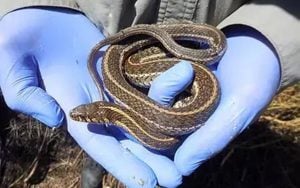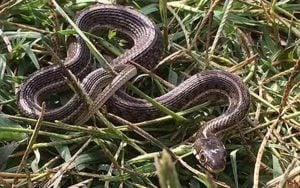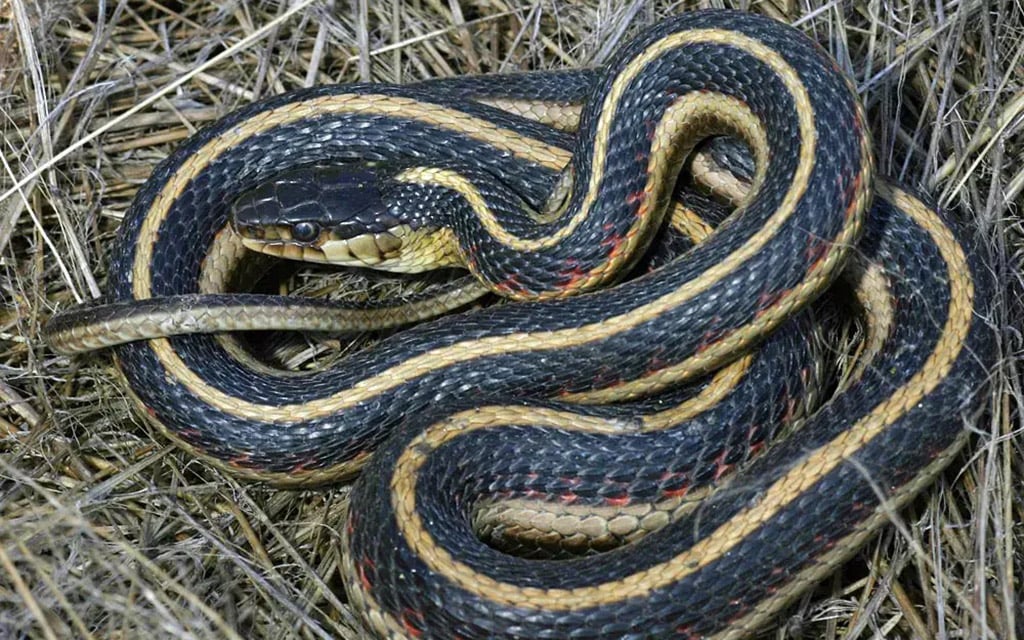WASHINGTON – The Center for Biological Diversity and Maricopa Audubon Society are accusing federal agencies of allowing livestock grazing that has put the northern Mexican garter snake at risk.
The rare wetland snake has lost 90% of its habitat in the past century and was declared threatened under the Endangered Species Act in 2014.
The two groups sued the Bureau of Land Management and U.S. Fish and Wildlife Service on July 11, asserting that livestock grazing on federal lands along the Big Sandy River in western Arizona is pushing the garter snake toward extinction.
“The snakes are in real trouble right now,” Chris Bugbee, a Southwest conservation advocate at the Center, which advocates for policies that protect threatened and endangered species, told Cronkite News. “They have disappeared quite dramatically. They have been extirpated from many previously known locations.”
The U.S. Fish and Wildlife Service declined to discuss the snakes, citing the lawsuit. So did the Bureau of Land Management, also part of the Department of the Interior.
In a filing last Friday with the U.S. district court in Tucson, the government broadly denied the allegations in the lawsuit without going into specifics.
But the U.S. Forest Service, part of USDA, acknowledged that grazing has impacted the snakes’ critical habitat. The Forest Service is not part of the lawsuit.
“The Forest Service does authorize grazing in some areas containing Northern Mexican garter snake critical habitat,” the agency told Cronkite News by email. “This grazing is implemented in accordance with Biological Opinions given by the U.S. Fish and Wildlife Service.”
The northern Mexican garter snake lives in riparian areas – that is, near rivers and streams.
In Arizona, the snakes have found homes in Page Springs and Bubbling Ponds State Fish Hatcheries; lower Tonto Creek; upper Santa Cruz River in the San Rafael Valley; the Bill Williams River; and the upper and middle Verde River, among other places.

Adult female northern Mexican garter snake with implanted radio transmitter. (Photo courtesy of the National Park Service)
The snakes aren’t venomous. They live up to 10 years in the wild and up to 20 years in captivity, and can grow to 44 inches. They’re olive, olive-brown or olive-gray, with three stripes that run the length of the body.
They feed on small animals such as frogs, tadpoles, fish, lizards and mice – though some invasive bullfrog species feed on baby snakes, a problem that state and federal agencies have worked to address.
The snakes are also prey for certain fish, birds and other snakes.
Environmental groups had pressed for federal protection for more than a decade before the snake was listed as threatened, blaming habitat loss and land degradation due to agricultural development, pollution and pesticides.
In 2021, the U.S. Fish and Wildlife Service designated 20,326 acres as critical habitat for the garter snakes, plus 11,860 acres on public lands managed by the Forest Service and the BLM.
But the Center for Biological Diversity asserts that federal agencies have put the snake at risk by allowing livestock to graze in pastures or rangeland on or near snake habitat.
The BLM manages livestock grazing on 155 million acres of public lands and administers nearly 18,000 permits. In Arizona, the BLM manages 11.5 million acres of rangeland available for livestock grazing, with 770 active grazing permits and leases on 841 allotments.
The Forest Service administers 6,250 permits with 104 allotments within Tonto National Forest and 200 allotments in Coronado National Park.
A Sept. 10 report from the Center said cattle grazing that it deems illegal had damaged about 60% of the snake’s critical habitat in Arizona. That was based on a survey of 8,127 acres (69%) of the garter snake’s designated habitat on public land.
The report cited significant impacts between 2021 and 2023 on 84% of the land surveyed.
“By habitually prioritizing commercial livestock over the needs of rare native plants and animals, federal agencies are pushing these beautiful reptiles toward extinction,” Bugbee said.
Cattle remove vegetation along streams and rivers, degrade soil and change the function of watersheds, destroying the snake’s habitat, he said. “Those places are supposed to be set aside for their recovery. We find it in such a highly degraded state that is very concerning to us.”
The Bureau of Land Management wouldn’t discuss the Big Sandy area at issue in the latest lawsuit.

A neonate (young snake) northern Mexican garter snake. (Photo courtesy of the National Park Service)
But the BLM said it has taken steps in the past year to address impacts from unauthorized grazing in San Pedro Riparian Conservation Area, a 57,000-acre border area in Cochise County where the snake has also been spotted.
In the past year, the bureau said, more than 100 head of unauthorized livestock were removed from the conservation area. To keep them out, BLM built 6 miles of fencing around a marshy wetland called the St. David Cienega, and worked with nearby landowners to build another 24 miles of fencing.
The agency plans to spend $2.5 million more on fencing in that area and vowed to “ensure the long-term health of the river and associated habitat.”
The U.S. Forest Service said forest restoration projects planned for Arizona will expand garter snake habitat. Whenever livestock get into an unauthorized area, the Forest Service works with the rancher to remove the cattle and remedy the situation, the agency said.
The Arizona Game and Fish Department took issue with the Center for Biological Diversity report.
Tom Jones, amphibians and reptiles program manager at the department, called the report exaggerated and “poorly done,” asserting that much of the land the Center for Biological Diversity surveyed is “far outside of critical habitat for the northern Mexican garter snakes.”
He acknowledged that grazing can affect snake habitat.
“The habitat changes, I understand that, but we have not seen an effect on the snake populations that we have been monitoring, and we survey these snakes every year,” he said.
Jones said Game and Fish monitors the snake populations and works with ranchers to raise the snakes in captivity and release them into the wild, adding that the population has slowly increased since 2014 when it was declared threatened.
“We have removed invasive species like the American bullfrogs from some of the habitats that these snakes occur in so that the snakes can go back to those habitats without that invasive predator being there,” he said.
The bullfrogs prey on young garter snakes. They also push out native leopard frogs that garter snakes feed on – a problem the federal Department of the Interior has also been addressing for years.
The snakes “are on their way to becoming endangered,” Bugbee said. “We want livestock out of all riparian areas in the West. These are keystone ecosystems that need a chance to recover for the benefit of water and wildlife.”

